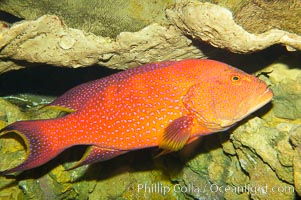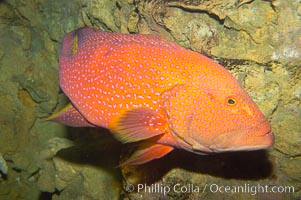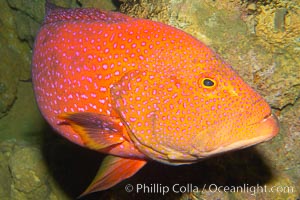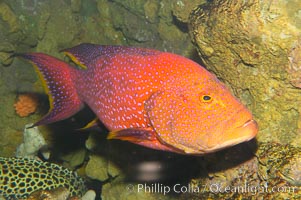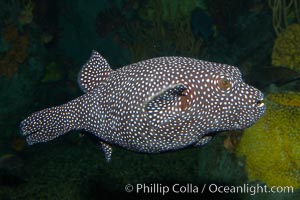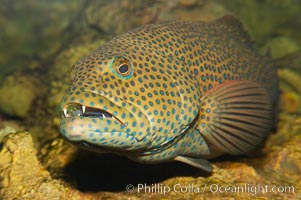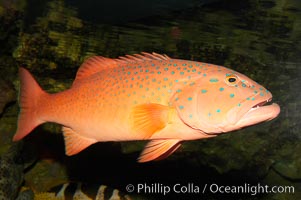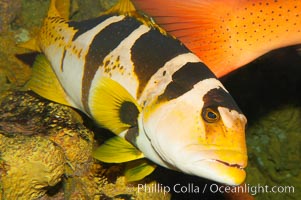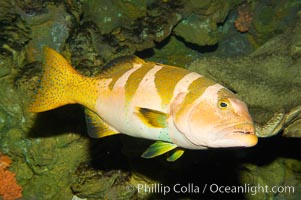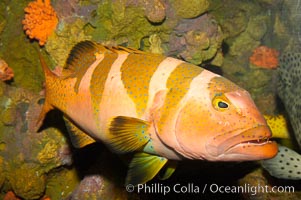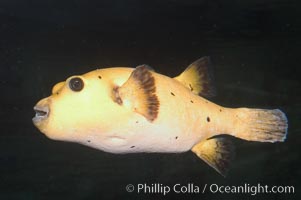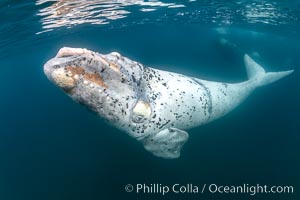
White southern right whale calf underwater, Eubalaena australis. About five per cent of southern right whales are born white due to a condition known as grey morphism and will gradually turn dark as they age. They are not albino (which is a complete lack of pigmentation). Sometimes referred to as "brindled", the white coloration is a recessive genetic trait and only lasts a few months. Typically, but not always, white calves will become much darker as they mature but will still be somewhat lighter than normal even as adults.
Species: Southern Right Whale, Eubalaena australis
Location: Puerto Piramides, Chubut, Argentina
Image ID: 35908
Species: Southern Right Whale, Eubalaena australis
Location: Puerto Piramides, Chubut, Argentina
Image ID: 35908
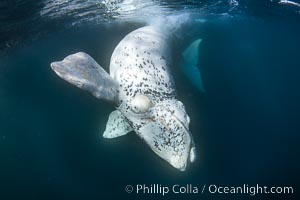
White southern right whale calf underwater, Eubalaena australis. About five per cent of southern right whales are born white due to a condition known as grey morphism and will gradually turn dark as they age. They are not albino (which is a complete lack of pigmentation). Sometimes referred to as "brindled", the white coloration is a recessive genetic trait and only lasts a few months. Typically, but not always, white calves will become much darker as they mature but will still be somewhat lighter than normal even as adults.
Species: Southern Right Whale, Eubalaena australis
Location: Puerto Piramides, Chubut, Argentina
Image ID: 38279
Species: Southern Right Whale, Eubalaena australis
Location: Puerto Piramides, Chubut, Argentina
Image ID: 38279
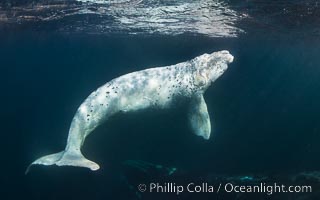
White southern right whale calf underwater, Eubalaena australis. About five per cent of southern right whales are born white due to a condition known as grey morphism and will gradually turn dark as they age. They are not albino (which is a complete lack of pigmentation). Sometimes referred to as "brindled", the white coloration is a recessive genetic trait and only lasts a few months. Typically, but not always, white calves will become much darker as they mature but will still be somewhat lighter than normal even as adults.
Species: Southern Right Whale, Eubalaena australis
Location: Puerto Piramides, Chubut, Argentina
Image ID: 38261
Species: Southern Right Whale, Eubalaena australis
Location: Puerto Piramides, Chubut, Argentina
Image ID: 38261
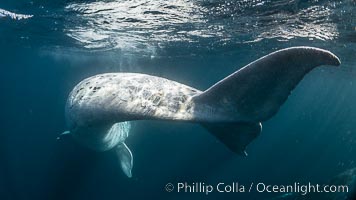
White southern right whale calf underwater, Eubalaena australis. About five per cent of southern right whales are born white due to a condition known as grey morphism and will gradually turn dark as they age. They are not albino (which is a complete lack of pigmentation). Sometimes referred to as "brindled", the white coloration is a recessive genetic trait and only lasts a few months. Typically, but not always, white calves will become much darker as they mature but will still be somewhat lighter than normal even as adults.
Species: Southern Right Whale, Eubalaena australis
Location: Puerto Piramides, Chubut, Argentina
Image ID: 38434
Species: Southern Right Whale, Eubalaena australis
Location: Puerto Piramides, Chubut, Argentina
Image ID: 38434
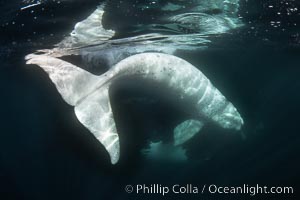
White southern right whale calf underwater, Eubalaena australis. About five per cent of southern right whales are born white due to a condition known as grey morphism and will gradually turn dark as they age. They are not albino (which is a complete lack of pigmentation). Sometimes referred to as "brindled", the white coloration is a recessive genetic trait and only lasts a few months. Typically, but not always, white calves will become much darker as they mature but will still be somewhat lighter than normal even as adults.
Species: Southern Right Whale, Eubalaena australis
Location: Puerto Piramides, Chubut, Argentina
Image ID: 38438
Species: Southern Right Whale, Eubalaena australis
Location: Puerto Piramides, Chubut, Argentina
Image ID: 38438
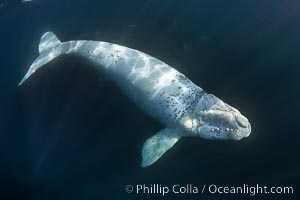
White southern right whale calf underwater, Eubalaena australis. About five per cent of southern right whales are born white due to a condition known as grey morphism and will gradually turn dark as they age. They are not albino (which is a complete lack of pigmentation). Sometimes referred to as "brindled", the white coloration is a recessive genetic trait and only lasts a few months. Typically, but not always, white calves will become much darker as they mature but will still be somewhat lighter than normal even as adults.
Species: Southern Right Whale, Eubalaena australis
Location: Puerto Piramides, Chubut, Argentina
Image ID: 38276
Species: Southern Right Whale, Eubalaena australis
Location: Puerto Piramides, Chubut, Argentina
Image ID: 38276
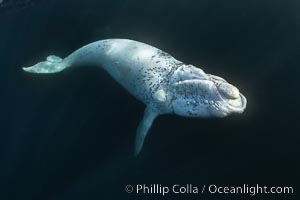
White southern right whale calf underwater, Eubalaena australis. About five per cent of southern right whales are born white due to a condition known as grey morphism and will gradually turn dark as they age. They are not albino (which is a complete lack of pigmentation). Sometimes referred to as "brindled", the white coloration is a recessive genetic trait and only lasts a few months. Typically, but not always, white calves will become much darker as they mature but will still be somewhat lighter than normal even as adults.
Species: Southern Right Whale, Eubalaena australis
Location: Puerto Piramides, Chubut, Argentina
Image ID: 38277
Species: Southern Right Whale, Eubalaena australis
Location: Puerto Piramides, Chubut, Argentina
Image ID: 38277
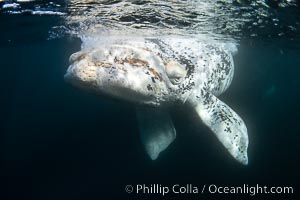
White southern right whale calf underwater, Eubalaena australis. About five per cent of southern right whales are born white due to a condition known as grey morphism and will gradually turn dark as they age. They are not albino (which is a complete lack of pigmentation). Sometimes referred to as "brindled", the white coloration is a recessive genetic trait and only lasts a few months. Typically, but not always, white calves will become much darker as they mature but will still be somewhat lighter than normal even as adults.
Species: Southern Right Whale, Eubalaena australis
Location: Puerto Piramides, Chubut, Argentina
Image ID: 38278
Species: Southern Right Whale, Eubalaena australis
Location: Puerto Piramides, Chubut, Argentina
Image ID: 38278
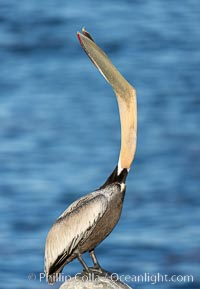
California Brown Pelican head throw, stretching its throat to keep it flexible and healthy. Note the unusual yellow coloration of the gular pouch, which is normally red in winter adults. Yellow morph.
Species: Brown Pelican, Pelecanus occidentalis, Pelecanus occidentalis californicus
Location: La Jolla, California
Image ID: 36714
Species: Brown Pelican, Pelecanus occidentalis, Pelecanus occidentalis californicus
Location: La Jolla, California
Image ID: 36714
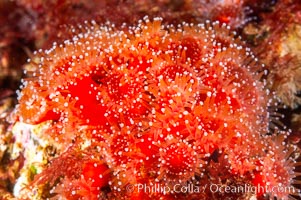
A cluster of vibrantly-colored strawberry anemones (club-tipped anemone, more correctly a corallimorph) polyps clings to the rocky reef.
Species: Strawberry anemone, Corynactis californica
Location: Santa Barbara Island, California
Image ID: 10168
Species: Strawberry anemone, Corynactis californica
Location: Santa Barbara Island, California
Image ID: 10168
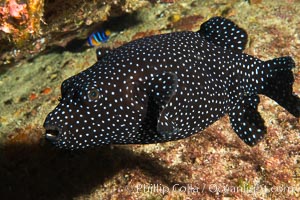
Guineafowl puffer fish, black phase.
Location: Isla San Diego, Baja California, Mexico
Image ID: 33541
Location: Isla San Diego, Baja California, Mexico
Image ID: 33541
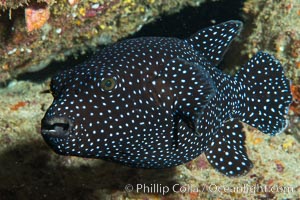
Guineafowl puffer fish, black phase.
Location: Isla San Diego, Baja California, Mexico
Image ID: 33542
Location: Isla San Diego, Baja California, Mexico
Image ID: 33542
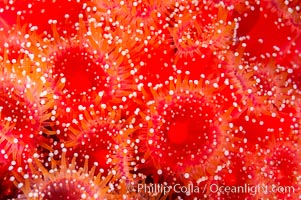
A cluster of vibrantly-colored strawberry anemones (club-tipped anemone, more correctly a corallimorph) polyps clings to the rocky reef.
Species: Strawberry anemone, Corynactis californica
Location: Santa Barbara Island, California
Image ID: 10163
Species: Strawberry anemone, Corynactis californica
Location: Santa Barbara Island, California
Image ID: 10163
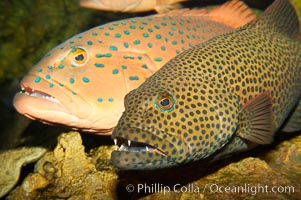
Squaretail coralgrouper (front) and spotted coralgrouper (rear).
Species: Squaretail coralgrouper, Plectropomus areolatus, Plectropomus maculatus
Image ID: 12914
Species: Squaretail coralgrouper, Plectropomus areolatus, Plectropomus maculatus
Image ID: 12914
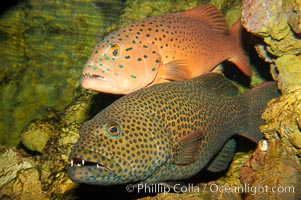
Squaretail coralgrouper (front) and spotted coralgrouper (rear).
Species: Squaretail coralgrouper, Plectropomus areolatus, Plectropomus maculatus
Image ID: 12915
Species: Squaretail coralgrouper, Plectropomus areolatus, Plectropomus maculatus
Image ID: 12915
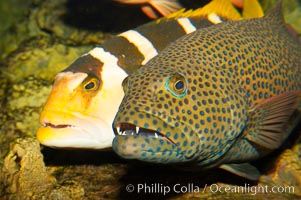
Squaretail coralgrouper (front) and saddleback coralgrouper (rear).
Species: Squaretail coralgrouper, Plectropomus areolatus, Plectropomus laevis
Image ID: 12916
Species: Squaretail coralgrouper, Plectropomus areolatus, Plectropomus laevis
Image ID: 12916
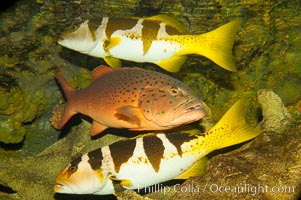
Spotted coralgrouper (center) and two saddleback coralgrouper (top, bottom).
Species: Spotted coralgrouper, Plectropomus laevis, Plectropomus maculatus
Image ID: 12918
Species: Spotted coralgrouper, Plectropomus laevis, Plectropomus maculatus
Image ID: 12918
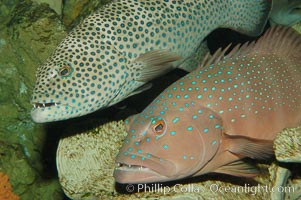
Squaretail coralgrouper (upper) and spotted coralgrouper (lower).
Species: Squaretail coralgrouper, Plectropomus areolatus, Plectropomus maculatus
Image ID: 08835
Species: Squaretail coralgrouper, Plectropomus areolatus, Plectropomus maculatus
Image ID: 08835
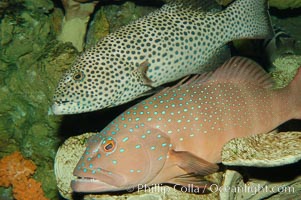
Squaretail coralgrouper (upper) and spotted coralgrouper (lower).
Species: Squaretail coralgrouper, Plectropomus areolatus, Plectropomus maculatus
Image ID: 08836
Species: Squaretail coralgrouper, Plectropomus areolatus, Plectropomus maculatus
Image ID: 08836
